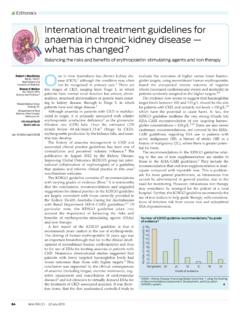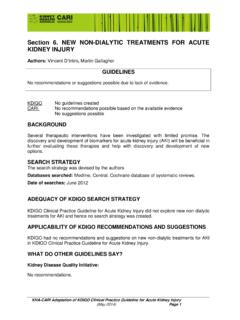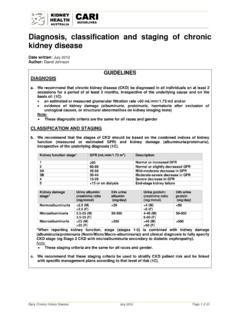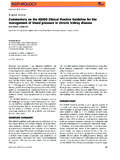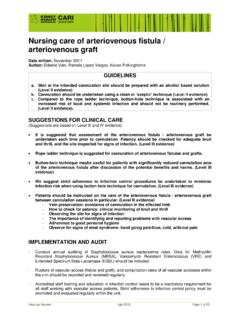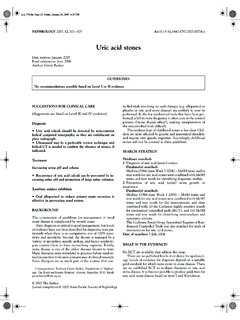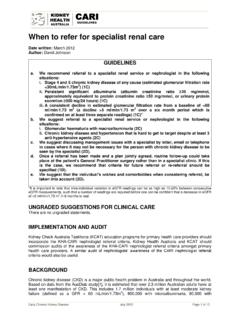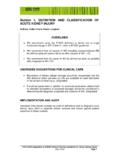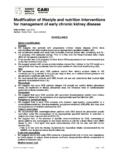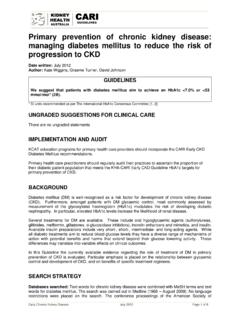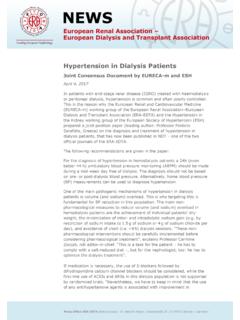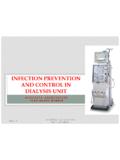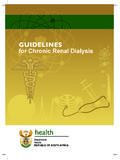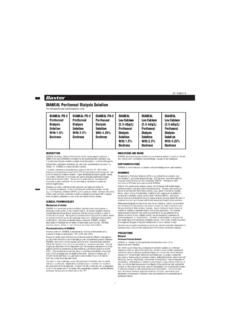Transcription of Calcium and phosphate product - KHA-CARI Mission
1 The CARI Guidelines Caring for Australasians with Renal Impairment Biochemical and Haematological Targets (April 2006) Page 1 Calcium x phosphate product Date written: August 2005 Final submission: October 2005 Author: Carmel Hawley GUIDELINES No recommendations possible based on Level I or II evidence SUGGESTIONS FOR CLINICAL CARE (Suggestions are based on Level III and IV evidence) In Stage 5 kidney disease, serum Calcium (albumin-corrected) x phosphate product < mmol/L is recommended. (Level III evidence cohort data; strong effect; consistent finding) Background Since the early 1970s, Calcium x phosphate has been regarded as a risk factor for extraskeletal calcification, particularly tumoral calcinosis, with the general consensus that it should not exceed 70 mg2/dL2 ( mmol2/L2). This review set out to explore the evidence to support an appropriate target range for the Calcium x phosphate product in patients with renal impairment by looking at extraskeletal outcomes.
2 Search strategy Databases searched: MeSH terms and text words for kidney dialysis were combined with MeSH terms and text words for serum Calcium . This search was carried out in Medline (1966 to April Week 3 2005). The Cochrane Renal Group Trials Register was also searched for Calcium and phosphate trials not indexed in Medline. Date of searches: 30 April 2005. What is the evidence? There are no available randomised controlled trials (RCTs) all data is at Level III or lower. However, the literature to date demonstrates a strong association between serum Calcium x phosphate product and all-cause mortality and cardiovascular mortality. There is also data linking serum Calcium x phosphate product to vascular calcification, which has been shown to be associated with mortality. The CARI Guidelines Caring for Australasians with Renal Impairment Biochemical and Haematological Targets (April 2006) Page 2 Summary of the evidence 1.
3 Is there a relationship between Calcium x phosphate product and extraskeletal outcomes? All-cause mortality There have been 4 observational studies exploring the relationship between serum Calcium x phosphate product and mortality in Stage 5 disease (Lundin et al 1980, Block et al 1998, Block et al 2004, Young et al 2005). Disease-specific mortality A number of studies have explored specific extraskeletal outcomes other than all-cause mortality, cardiovascular disease being the most studied. However, the outcome measure varied somewhat between studies. Ganesh et al (2001) demonstrated an association between Calcium x phosphate product and sudden death and death from coronary artery disease. Block et al (2004) found an association between Calcium x phosphate product and the risk of hospitalisation for cardiovascular disease and Young et al (2005) demonstrated the association between the Calcium x phosphate product and cardiovascular mortality.
4 A strong association between serum Calcium x phosphate product and cardiovascular mortality has been demonstrated. Additional summary comments Difficulty achieving guideline targets Young et al (2004) and other smaller studies (not listed in this guideline) have demonstrated that only a relatively modest percentage of patients fell within the guideline range in relation to control of serum phosphate and other parameters of bone mineral metabolism. Note: where the details of the trial design have been described in the Recommended target range for serum phosphate only the details pertaining to the data relating to Calcium x phosphate product will be given in this guideline. The total serum Calcium x phosphate product is an indicator of the risk of mineral crystallisation in soft tissues, (Meema et al 1976, Alfrey and Ibels 1978) which can lead to cutaneous and systemic calciphylaxis, conjunctival precipitation, visceral and in particular, cardiovascular calcification (Rostand et al 1988, Rumberger et al 1995, Braun et al 1996).
5 The in vivo solubility saturation point of Calcium x phosphate (mmol2/L2) has variously been estimated between (Hebert et al 1966) and (Herbert et al 1941). Individual patient variability will depend on factors such as plasma pH. However, under physiological conditions in vitro estimations have been lower (Logan 1940, McLean & Hinrichs 1938). If ionised (i) serum Calcium is used, a (i) Calcium x phosphate and Hinrichs product over (mmol/L)2 has been shown to increase the risk of soft tissue mineral precipitation (Nordin 1958, Lundin et al 1980). Nichols and co-workers (1990) studied 73 dialysis patients following parathyroidectomy. Those with progressive vascular calcification had serum The CARI Guidelines Caring for Australasians with Renal Impairment Biochemical and Haematological Targets (April 2006) Page 3 phosphate levels > mmol/L and elevated Calcium x phosphate products (Nichols et al 1990).
6 Lundin et al (1980) first identified an elevated Calcium x phosphate product as a predictor of cardiac mortality (along with age at onset of dialysis and sustained hypertension). In a random sample (controlled for age, sex, race, diabetes, smoking, AIDS and malignancy) of 2669 patients haemodialysed for > 1 year (mean years), taken from the US Renal Data System dialysis morbidity and mortality study wave 1, Block et al (1998) reported an increasing relative mortality risk above a Calcium (corrected to serum albumin 40 g/L) x phosphate product measured in mg/dL of 52 (the equivalent figure in mmol2/L2 is ). The relative mortality risk was for Calcium x phosphate products between and , for products and for products However, only levels above were statistically significant (P < ) compared to the reference range of suggested as desirable by Kates and Andress (1996).
7 Since in this cohort study no increased risk was attributable to serum Calcium alone, it suggests that risk with increasing Calcium x phosphate product is predominantly driven by hyperphosphataemia. Ganesh et al (2001) set out to look at whether serum phosphate was associated with specific causes of death in end-stage kidney disease (ESKD) patients and in particular, whether the association was with cardiovascular deaths. They published a large study using data again from the US Renal Data System with data from 2 random samples of a total of 12 833 haemodialysis patients who were followed for 2 years. In this study, a linear relationship between Calcium x phosphate product and both sudden death and death from coronary artery disease was demonstrated: an increased risk of sudden death, RR per 10 mg2/dL2 ( mmol2/L2), increase in Calcium x phosphate product (P < ) and an increased risk of death from coronary artery disease with RR , P < Block et al (2004) demonstrated that an increase in Calcium x phosphate product of mmol2/L2 compared with the reference range of mmol2/L2 is associated with an increased risk of (1) all-cause mortality: for Calcium phosphate product , RR (95% CI: ) ; for product , RR (95% CI: ) compared with the referent range of and (2) all-cause hospitalisation: for Calcium x phosphate product > mmol2/L2.
8 Young et al (2004) described the state of bone mineral metabolism from the DOPPS studies including DOPPS I (1996 2001) and DOPPS II (2002 2004). The proportion of patients with Calcium x phosphate < mmol2/L2 were for DOPPS I and for DOPPS II. Young et al (2005) reported the results of observational retrospective cohort data from units in the United States, Europe, and Japan as part of the dialysis Outcomes and Practice Patterns Study (DOPPS) including 307 dialysis facilities and 17 236 patients. Data was collected between 1996 and 2001. Altogether 17 236 patients were studied 8 615 at the start and 8 621 replacement patients. Patients were from the US, Germany, Italy, Spain and Japan. All-cause mortality was significantly and independently associated with serum Calcium x phosphorus product : RR per 5 mg2/dL2 ( mmol2 /L2), P = (increase in Calcium x phosphate product in a linear relationship).
9 Cardiovascular mortality was significantly associated with the Calcium x phosphorus product (RR per 5 mg2/dL2 ( mmol2 /L2), P < ). The CARI Guidelines Caring for Australasians with Renal Impairment Biochemical and Haematological Targets (April 2006) Page 4 What is the data in peritoneal dialysis ? There is no published morbidity/mortality study in relation to Calcium x phosphate product with peritoneal dialysis (PD). Continuous PD removes more phosphate than intermittent haemodialysis but this is more than offset by a higher dietary intake of phosphate -containing protein in PD patients (Blumenkrantz et al 1982, Delmez et al 1982). The use of predominantly Calcium salt oral phosphate binders to avoid aluminium or magnesium toxicity results in frequent hypercalcaemia and high (i) Calcium x phosphate product with peritoneal dialysate containing mmol/L Calcium (Salusky et al 1986, Martis et al 1989, Bender et al 1992).
10 Metastatic soft tissue calcification has therefore been common with chronic PD. However, reduction in PD dialysate Calcium to mmol/L has been shown in observational studies to reduce hypercalcaemia and provide better phosphate control by allowing the increased use of Calcium -based phosphate binders and vitamin D (Honkanen et al 1992, Hutchison et al 1992). More recently, the use of PD dialysate containing only mmol/L ionised Calcium has been shown in a 2-year randomised, controlled, German multicentre study to provide 3 times less hypercalcaemia and less aluminium accumulation from the use of aluminium salt phosphate binders (Weinreich et al 1996). However, 23% of the low- Calcium PD patients (vs of controls) progressed to having parathyroid hormone levels greater than 10 times the upper limit of normal suggesting that maintenance of a higher serum Calcium is important in suppressing PTH secretion (mean iCa was mmol/L in the low- Calcium PD patients vs in controls).
